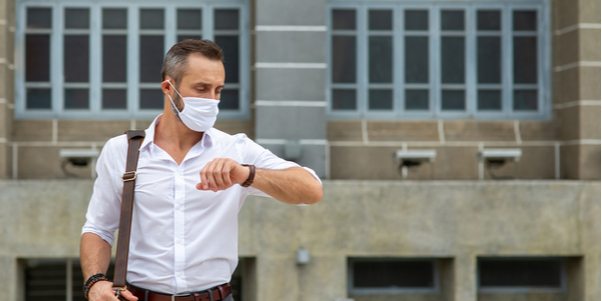Templers Safety and Security Ltd provide advice and guidance to SMEs to help them meet their health and safety responsibilities. The company was co-founded by Adam Schwalm, who has over fourteen years’ experience in the health and safety industry within a wide range of working environments, from government departments and local authorities to construction, excavation and utilities.
We spoke to Adam about how he’s working with local businesses to create plans and procedures to ensure their staff can return to work safely and securely. He shared with us his five-step process businesses can implement to protect the health and safety of their workers as they return to the workplace.
1. Create a Health and Safety assessment checklist
The first step is to assess what you have in place and may already be doing. For example, are you able to keep staff two metres apart? Have you implemented staggered working hours to reduce the number of people in your building at one time? And have your staff been instructed on what to do if they are experiencing Covid-19 symptoms?
Creating a checklist is a great way to monitor what you are already doing to protect your employees and allows you to identify any gaps where additional measures may be required.
It may be that some members of your team will continue working from home. If this is the case, it’s important not to forget about their health and safety. Have staff got the correct equipment to promote safe home working? For example, a suitable chair, a proper desk, a laptop stand as well as a separate keyboard and mouse? As an employer, it’s important to protect your workers from the health risks of working with display screen equipment (DSE), even if they are working remotely.
“People used to sit at a laptop for just a couple of hours. But now, if people are hunched over a laptop with no separate mouse and keyboard all day, their posture is going to be affected and it’s going to lead to problems. So doing a desk assessment is one of the best things to do. Also, it’s showing that the business is doing what they need to do to protect their staff.”
2. Carry out a workplace risk assessment
The next step is to carry out a risk assessment of your workplace. This involves:
- Identifying what work activity or situations might cause transmission of the virus
- Thinking about who could be at risk - e.g. people working in the area, visitors to the building
- Determining the likelihood that someone could be exposed
- Taking action to remove the activity or situation, or if this isn’t possible, taking steps to control the risk
The risk assessment should be set up with the same topics covered in the checklist but should delve deeper into how you intend to manage the risk of each hazard you identify.
"The assessment checklist looks at what you're already doing. The risk assessment backs that up by analysing the risk involved in every situation or activity."
3. Create a workplace action summary and plan
The risk assessment should provide you with a list of measures that now need to be implemented. This is where you can evaluate the practicality of implementing each measure and determine the necessary steps to ensure they are in place, ready for employees’ return to work and, if applicable, your re-opening to the public.
For example, Templers have recently worked with a local dance academy to create an action plan and procedures for how they can safely re-open to customers. Amongst other things, the plan involves asking students to come dressed ready for their class instead of using the changing rooms, as well as asking parents to wait outside while the students are led into the building by a teacher.
“Simple things like the toilets, how often do you clean them? How many people do you allow into the building at one time? All these things will need to be considered. But it's about doing what's reasonable.”
4. Communicate findings with your team
It’s all well and good introducing health and safety measures, but how you communicate those measures to your staff will determine how successful they are. Ensuring you share the correct information and guidance with your workers, as well as other people who may be entering the building, is key.
In a small business, it may be best to consult your workers directly. And when communicating the measures you’re putting in place, be sure to get their thoughts and ideas about how to keep people safe too.
“Rather than just telling people what’s going to happen, communicate and discuss the findings with them. They’re the people doing the work on the ground, and they’ll have good ideas about what changes may need to be made.”
5. Review regularly
Any risk assessment and action plan is only as good as the procedures you put in place, so be sure to monitor progress and review your findings on a regular basis. You may find that some things you’ve implemented might not be working effectively, and you will need to try new ways of doing things.
Wellbeing and support for employees
Beyond safety and security, part of Templers’ offering is to help SMEs support the mental health and wellbeing of their employees. Adam recommends encouraging people to talk about any concerns they have about returning to work and think about what can be done to make people feel safe. It’s also important to continue having those conversations so workers know they will be listened to and that, if necessary, action will be taken to change plans.
“The coronavirus pandemic has been a worrying time for everyone and it’s important that workers feel supported and listened to. It is crucial that their wellbeing is looked after while working.”
Templers have pulled all this information into a free Return to Work pack for businesses. The pack also includes free templates of the checklist, risk assessment and action plan that you can download and use. If you would like a copy, please contact Adam directly at TemplersSSL@outlook.com or get in touch via their website.
If you’re looking for advice and guidance, or a full gap analysis and review of what you do so you can ensure the health, safety and wellbeing of everyone in your business, Templers are currently offering a 20% discount on their services for Chamber members. Get in touch via the links above to find out more.





![The Bedford College Group logo [WHITE]](https://www.chamber-business.com/hs-fs/hubfs/The%20Bedford%20College%20Group%20logo%20%5BWHITE%5D.png?width=139&height=81&name=The%20Bedford%20College%20Group%20logo%20%5BWHITE%5D.png)
